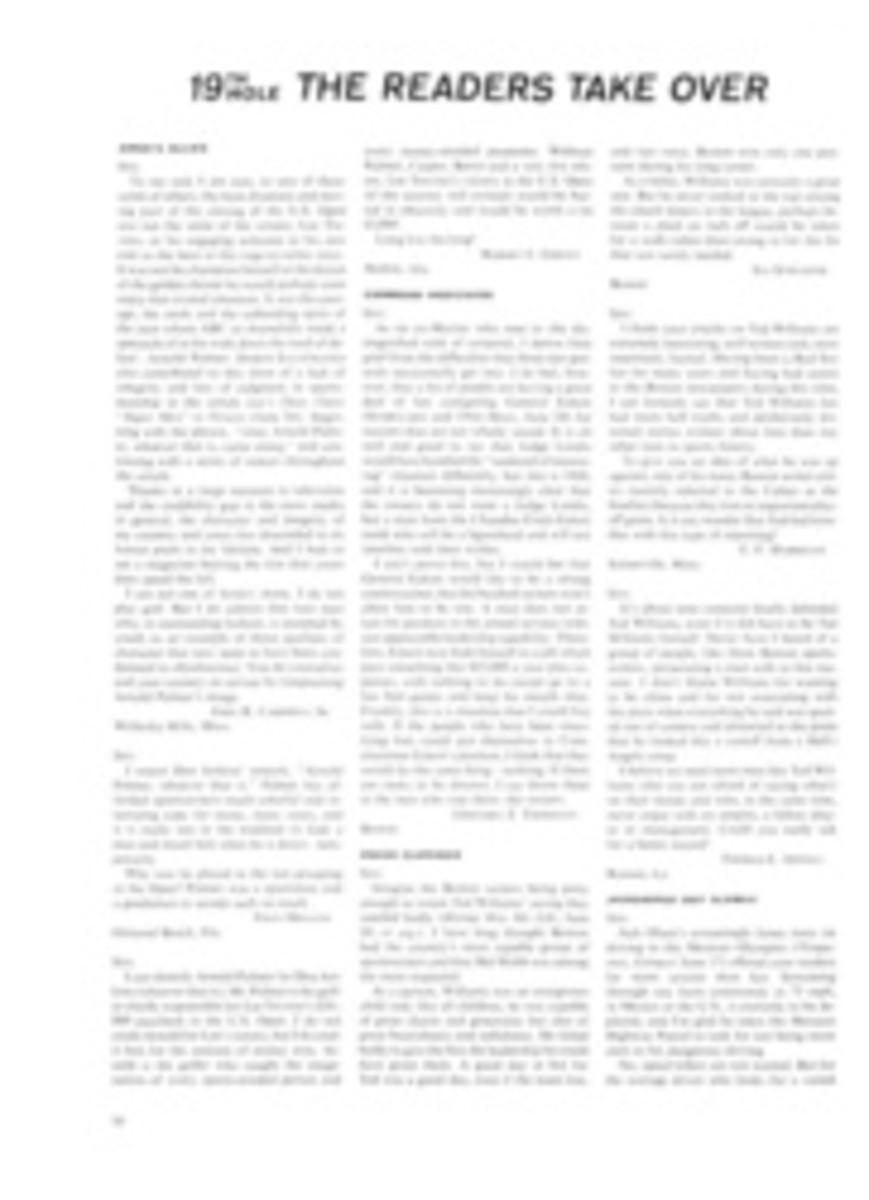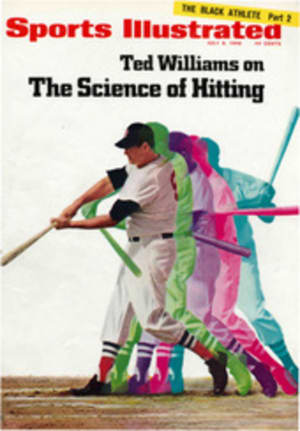
BERMUDA-BOUND MINUS BRENDA
Under sunny but somnolent skies and abuzz with preparations for the biennial blue-water race to Bermuda, the harbor at Newport, R.I. seemed last week a long, long way from a fury that was whipping the Atlantic hundreds of miles to the southeast. The fury was Brenda, an unusually early hurricane spawned in the warmth of the Sargasso Sea and threatening with winds up to 75 mph the solo sailors headed westward across the ocean from England in the London Observer's second transatlantic race for single-handers. Brenda seemed likely to move into the path that the Bermuda racers would have to take to get to Hamilton, and despite the grumbles of a few of the skippers, who boldly declared they wanted to get going hurricane or no, she was serious enough to cause the first postponement in the ocean classic's 62-year history. "We will not race." said the Cruising Club of America's Commodore Clayton Ewing, "if the storm seems likely to threaten the fleet." Nor did they, for a full 24 hours.
Meanwhile, far out at sea, solo sailor Geoffrey Williams was holding his 57-footer Sir Thomas Lipton on a southeast course with only two thoughts in mind: to miss the storm if possible and to get to Newport first. Oddly enough, there wasn't a racing skipper in the Ida Lewis Yacht Club or the bar at Christies who didn't envy him, for storms are the least of a Bermuda race competitor's worries and getting there first is often only an illusion. The hazards that face a Bermuda skipper swirl and swing around a labyrinthine handicapping system in which water-lines, sail areas, overall lengths, drafts, overhangs and propeller apertures are balanced against each other to provide what is known as a rating. The lower the rating, the higher the handicap and the better a boat's chances of winning the race.
Year after year on the blue-water circuit dissatisfaction with this system mounts, and there is a growing ground-swell for a simpler handicapping rule based, say, on waterline length alone instead of reckoned in the dark of night by a system of mathematical black magic. But still the old complex system persists—and perhaps for good reason.
If the Bermuda race this year were a matter of simply getting there first, as the solo transatlantic was, there would have been no race at all. Even after a bad start, veteran ocean racer Sumner A. (Huey) Long's big (73 feet), fabulously expensive ($500,000) dreadnaught of a ketch Ondine, the most powerful ocean racer seen in years, simply took off, passed what little opposition there was in her way, sailed along on fair winds all the way to Hamilton, dropped anchor and waited around for the rest of the fleet.
Ondine did face one moment of crisis on the way down. Her brand-new air-conditioning system conked out midway during the race, and for a full hour her racing crew had to suffer the full agony of the summery 80° heat. Aside from overcoming this hardship, Owner Long's only satisfaction lay in crossing the line first. Built solely to move fast and the hell with handicaps, his huge and swift racer did not win any corrected-time prizes. Under the present rating system, which is designed to favor the smaller craft, great big boats like Ondine have almost no chance at all. Even the smaller boats however, are forced to play the odds in one way or another.
One way is to build a boat so swift that no other craft of her class can sail with her. One such this year was Rage, a magnificent 53-foot sloop designed, built and sailed by Charlie Morgan of St. Petersburg, Fla. for Homer Denius. Constructed more like a miniature 12-meter than an ocean racer, Rage piles so much sail on her tall spar and carries it so well that even with a higher rating she has handily beaten most other boats of her size. She did it again last week when she took Class B honors and second overall.
Another way to beat the odds is by finding loopholes in the rating rule itself and exploiting them to the limit. At least three entries in this year's Bermuda were frankly out to grab a prize by this method. One was an ugly little monster named Babe, who might have been a Cal 40 with a Cal 40's rating if her owner, Arnold Gay of Annapolis. Md., had let her be. But, said Gay, "I always wanted to build an all-out boat for the Bermuda race," and so he went to work.
To begin with, Gay sliced off three feet from Babe's stern and replaced it with a jutting spar called a boomkin. Under the rule this made his boat three feet shorter but she could still carry even more sail than before. Next, to make his boat heel less in a breeze, Gay replaced the Cal 40's normally heavy deck with one 900 pounds lighter. He then took the 900 pounds, turned it into lead ballast and put that in his keel, thus providing not only added stiffness but the longer waterline that makes any boat go faster.
Another might-have-been Cal 40 cleverly redesigned as a Cal 37 from her very conception was Justin Wasley's Windquest. Still another was T. Vincent Learson's Thunderbird, which won the race as a genuine Cal 40 two years ago. Not satisfied with that triumph, Learson this year chopped off some of Thunderbird's stern and added a boomkin like Babe's. His modifications were not drastic enough to change her class, only her rating.
It is unlikely that any of this sawing and adjustment added half a knot of speed to any of the three boats. What it did in each case was to lower the rating and hence make each boat's speed more valuable in the final tally. For Windquest and Thunderbird, though not for Babe, the jiggering paid off with a first place in each of their classes. As for Babe, she finished fifth in hers. Owner Gay had the good sense to hang on to his sawed-off stern, "so when they change the rule to close that particular loophole, I'll be able to stick it back on." They are going to close it. The CCA measurement committee has already assured Gay and the others of that.
In the end, however, no matter what loopholes are shut off or others opened up, the race in 1970 may be won, as it was this year, by a simple combination of good luck, good design and good all-round seamanship. Actually, it should not have surprised anyone in either Newport or Hamilton when Ted Hood of Marblehead, Mass. sailed his beautiful blue yawl Robin to overall victory. The surprise lay in learning that Hood, one of America's best-known racing yachtsmen, had never sailed the Bermuda before. It was like telling a horseplayer that Eddie Arcaro had never ridden in the Derby.
Besides being a sailmaker without peer anywhere in the world, Hood designs and builds championship boats and has raced them in virtually every kind of topflight competition, including the America's Cup itself.
Sailing with Hood aboard Robin was as impressive a crew of experts as you could hope to find anywhere at sea, including, as navigator, Bob Bavier, the skipper of the 1964 America's Cup defender Constellation. Under Hood's urging, they drove his boat out of Newport and into the Gulf Stream through a keyhole five miles west of the most direct route to Bermuda, got the right help from the thrusting current and slid serenely to the finish line off St. David's Light in 3 days 20 hours 14 minutes 3 seconds which, under Robin's rating, corrected to 3:06:04:19.
It added up to one of the easiest runs in Bermuda race history. As the race began, the once-menacing Brenda disappeared off to the northeast leaving behind southwest breezes that never got above 40 mph for most of the fleet.
Only once did Robin's crew have to set a spinnaker, and then only for a brief spell. The rest of the time they spent trimming sails or changing an occasional headsail to compensate for changes in the winds. Somewhere to the east a series of squalls ripped the masts from two boats, Saphedra and Huntress, and damaged another, Vamp XX, an early favorite, which limped home with rudder problems, but for Robin the trip was no more strenuous than the voyage of a candy boat across a frosted cake.
A little more than a year old, designed by Hood and built of steel, the 52-foot Robin is no Spartan racing machine. En route to Bermuda, her crew was almost luxuriously berthed in four big separate cabins. With a raked transom, shortened cabin trunk and powerful bow, she seems to epitomize what every good ocean racer should look like, but underwater she is unique.
Down where it counts, instead of the heavy permanent keel people normally associate with an offshore racer, Robin has something that looks more like a dagger board on a Sunfish: a narrow knifelike centerboard so deep that when raised it slices right up through the main cabin. This gives Robin great power for climbing to windward. Yet, sliding before the wind with her centerboard raised, she becomes a whopping big, round-bottomed dinghy.
As Robin lay at the winner's berth off the yacht club's dock last week she drew visitors by the score, all of whom inevitably asked Hood: "Hey, Ted, how do you account for winning your first Bermuda race?"
"Agh, um," replied Hood, who sails better than he talks, "I guess we just didn't do too many things wrong." It was as good an explanation as any.
PHOTO
ERIC SCHWEIKARDT
PHOTO
ERIC SCHWEIKARDT
Pushed swiftly along the Gulf Stream current by brisk winds, novice Bermuda man Ted Hood's yawl "Robin" was an easy first on corrected time.
TWO PHOTOS
ERIC SCHWEIKARDT
Foot for foot, the two fastest boats in the race were Huey Long's new 73-foot ketch "Ondine" (top) and Homer Denius' 53-foot sloop "Rage."

